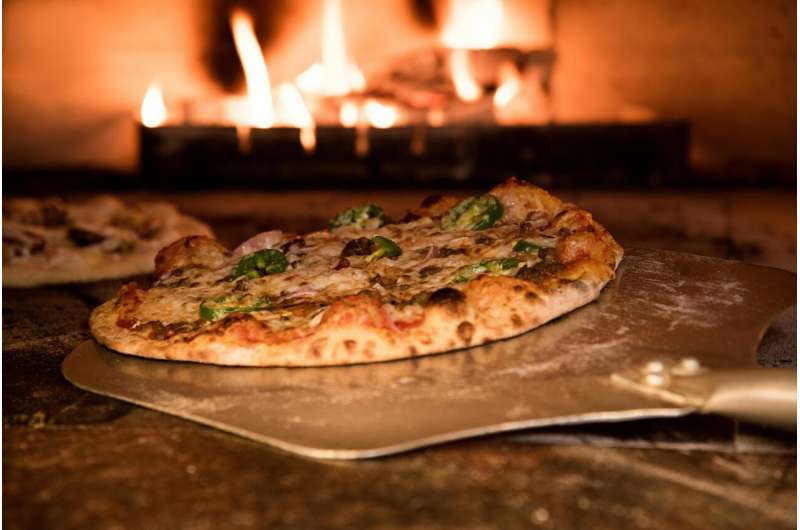This article has been reviewed according to Science X's editorial process and policies. Editors have highlighted the following attributes while ensuring the content's credibility:
fact-checked
trusted source
proofread
The flavors of fire: How does heat make food taste good?

Sure, cooking our food can make it safer to eat and more digestible. But let's be honest. We mainly cook to create something we enjoy—something delicious.
So how exactly does heat produce these tasty flavors? And why do we all have different flavor preferences?
Complexity on a plate
Simon Warwick is a lecturer at Curtin University who specializes in food chemistry. He says there's a lot more to the science behind flavors than we might think.
"Food science covers many areas, not just the chemistry," says Simon. "There's also the sensory analysis, the taste buds and how they work."
Mouthfeel refers to how food physically feels in your mouth. Is it creamy? Crunchy? Sticky? Does it coat your mouth, or cause a tingling sensation?
"So there's physiology involved, as well as psychology," says Simon.
But let's start with some sweet cooking chemistry.
Sweet, sweet chemicals
Sugars naturally occur in many foods, pleasing our taste buds with their high-energy sweetness. Adding heat can make extra-yummy flavors through a process known as caramelization.
"High heat breaks the bonds in simple sugars like glucose. These then form new bonds, making larger molecules and changing their overall shape," says Simon. "These large molecules absorb some light, causing a brown color."
Caramelization is what makes a crispy brown coating on your toasted marshmallow. It can also lead to a bunch of different flavors depending on the sugars involved.
Simon says any good food chemistry book will feature a whole list of possible sugary compounds.
Diacetyl, for example, is responsible for buttery or butterscotch flavors. Maltol is attributed to toasty flavors.
"And they're all slightly different in how we respond to them," says Simon. "The more you heat the caramel, the more bitter tones are produced as well. Many people enjoy that combination," he says.
Protein performance
Next are proteins, which are incredibly complex molecules.
Dr. Wendy Hunt, Academic Chair of Food Science and Nutrition at Murdoch University, says that proteins are made of hundreds of amino acids arranged with four levels of structure.
Heating changes protein structure and affects food flavors and textures.
"Heat causes the structures to denature or break. They can interact with other chemicals in food to create new and delicious flavors," says Wendy. "Changes caused by heat are reversible up to a certain point, but after that, more heat can cause proteins to coagulate.
"This is what you see when you cook an egg. The protein in the egg white coagulates and changes from clear liquid to firm white."
It can also have the opposite effect, explains Cyprian Maynard, an Adelaide-based chef of 20 years.
"Beans are a good example. If you cook them too long, the protein breaks down and they become soft and mushy," he says.
Both the mouthfeel and flavors of these foods are wildly altered by the addition of heat.
"In a professional kitchen, taste and texture are both important," says Cyprian. "If you don't sear meat when you start to cook it, it can become dry and tough to chew."
Smoking hot
And when you're cooking with fire, heat isn't the only player in the game. Smoke plays its own role in fiddling with flavors.
"Smoke from burning wood has volatile compounds like guaiacol and syringol," explains Wendy. "[These] give foods a characteristic smoky flavor."
Cold smoking, commonly used for salmon, can add smoky characteristics to the fish. Hot smoking, like with meat and veg on a barbecue, adds even more complex flavor profiles.
"[These are] caused by heat-induced chemical reactions with the smoke," says Wendy.
Food will absorb different flavors from smoke depending on its fat and water content and where the smoke is coming from.
Cyprian has used a variety of smoke sources to create different smoky flavors in his restaurants.
"I've used tea to smoke duck as well as hickory chips, and both have added very different flavors to the meat," says Cyprian.
A method to the madness
How you apply heat to your food also has a big impact on its resulting flavor.
Have you ever argued with someone over the best way to cook a potato? Because food scientists certainly have.
One such study compared the flavor and chemical profile of baked, boiled and steamed sweet potatoes.
The lucky tasting panelists scored the potatoes on sweetness, starchiness, viscosity, fibrous texture, firmness and overall taste. They found that baked potatoes were sweeter, with higher levels of sugars and volatile compounds.
Boiled potatoes retained more moisture and had a softer texture, affecting the overall mouthfeel. Steamed potatoes scored somewhere between the two for most categories.
One-track minded
So which cooking method is the tastiest overall? That depends on how you feel about it.
This is because culture and psychology are also major players in the favorite flavors game.
Simon says you can love certain flavors purely because of associated positive memories.
"[For example], burned marshmallows are mixed with sweet flavors and have positive emotions attached [for me], like going camping with my kids," says Simon. "This can improve [my] perception of the taste."
Cyprian notes that many of his most popular restaurant dishes were traditional favorites cooked in a familiar way.
"People come back time and time again to experience the nostalgia and the good memories—just like Mumma used to make," he says. "I still love baking and roasting, probably because this is how my Grandma used to cook."
Provided by Particle
This article first appeared on Particle, a science news website based at Scitech, Perth, Australia. Read the original article.





















